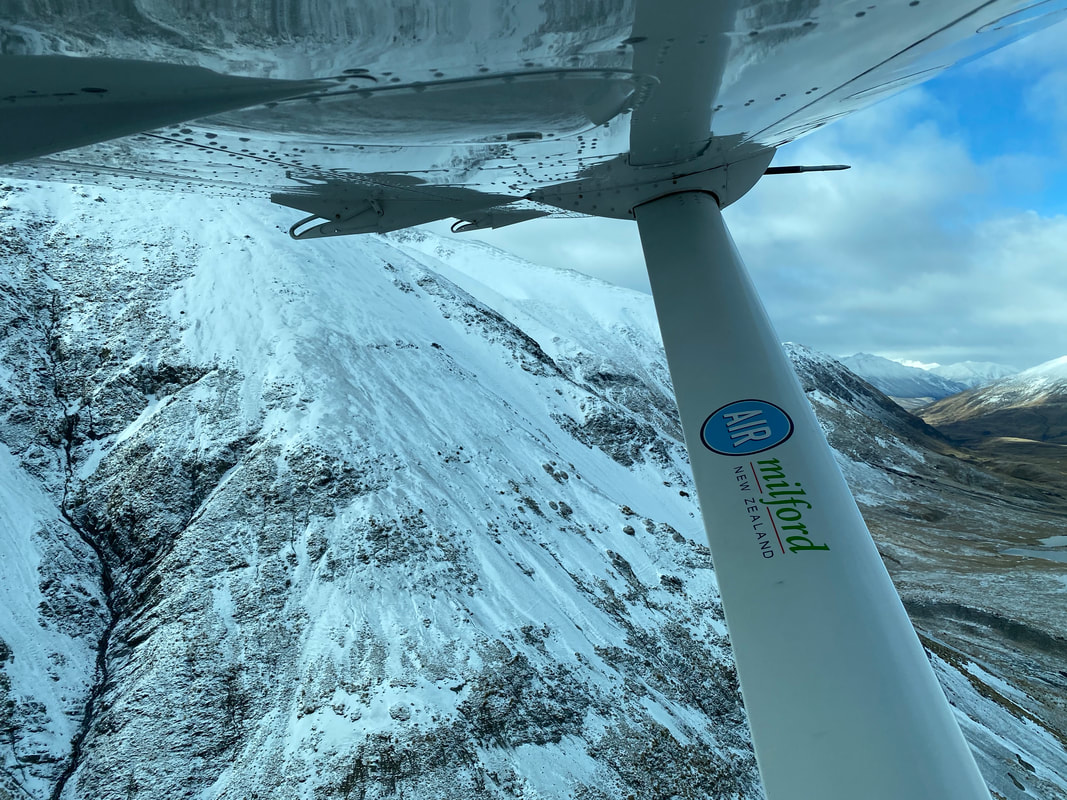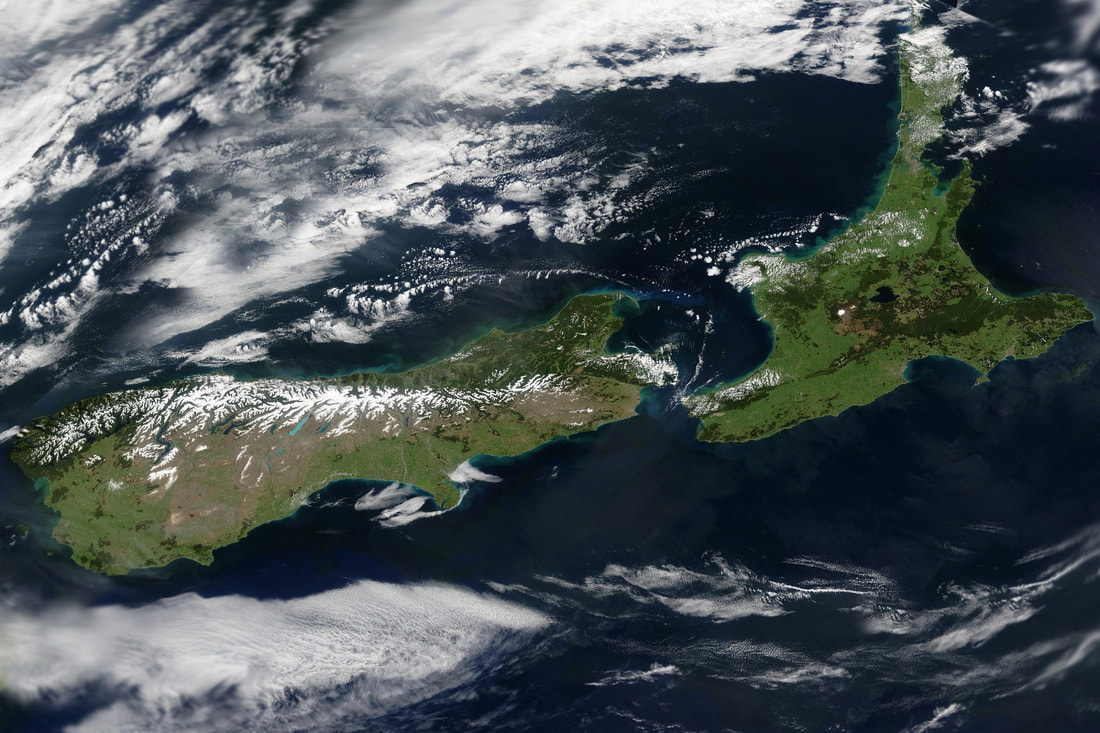|
Photos & Story - Samoa Events Lake Wakatipu surrounded by all the men, Mts Cecil, Crichton, Ben Lomond and Nicholas. Plan B it was for The Cold Tour today on Day 4 and the final day of the tour. Everyone had been looking forward to the Milford Sound trip and the swim to Stirling Falls. We also planned to fly by helicopter to Lake Quill in the Fiordland National Park for a quick swim. It was not to be. High wind and low visibility put an end to the dream finish to the tour – so we thought. So, we boarded Air Milford’s latest addition to their 5-plane fleet, a 10-seater Cessna Caravan ZK purchased new in 2016 direct from the factory in Wichita, Kansas. The seating arrangement today had me sit directly behind the pilot with Kerren directly across, Simon was in the co-chair. Duncan, the mouthpiece and laugh-machine of the tour sat behind me and the ladies occupied the rest of the seats behind us. It was a squeeze with all our luggage, but everyone had a window view. Our pilot today is Antony (Ant) Sproull, GM and Chief pilot of this beautiful family airline. Air Milford was founded by Ant’s father Hank who still works the business and helped load our gear. The airline has a 100% safety record with all aircraft being personally maintained by the owners. There is a connection between Air Milford and Samoa, Ant told me that he flew to Samoa with his father Hank in 1992 to purchase a topdressing Cessna from the Samoa Government. That aircraft was a casualty of Cyclone Valelia (1991) and they picked up a bargain. Ant told me that he sat in the co-pilot’s seat as a little boy next to his father flying that plane which was repaired and sold for a nice little margin. The profit from the sale helped launch Air Milford in 1998. There were plenty of similar stories from Ant as he flew us to Te Anau. He showed us where his grandfather camped on the shores of Lake Te Anau hunting game and he told of how his father would drop him and sibling off sometimes at a remote lake to fish and play while Hank went off to do a job. That was his childhood. He has been in aviation ever since. We were met with a warm welcome at Air Milford where we were given a thorough briefing of our flight path by pilot Antony Sproull who is General Manager and Chief pilot of the family-run airline. Ant was a safe pair of hands, not that a few of us cared. For some in our crew, this was their very first flight in a small aircraft and there were nerves. We took off from Queenstown airport with a great view of Lake Hayes and the Remarkables. Wakatipu below us was surrounded by snow-capped mountains was a visual feast. It helped that today was the best weather-day of the tour and the sun was out giving colour and light to water, mountains and sheep stations below. We flew southward for a short distance with Queenstown town to our right. All the boys are dressed in their Sunday best gleaming in the morning sun with snow flowing mountains to 500 meters; Mounts Cecil to our left, Ben Lomond and Crichton to our right and the remarkable Remarkables now fast receding on our left seemed to be keeping everyone in best behaviour. We also saw in context the sites of the two of the earlier swims of the tour on Days 1 and 2. Whatever we did in those two swims, it was barely a drop in what we were now witnessing, Lake Wakatipu in a long big stretch from north to south in the shape of Matau the Taniwha (See blog for Day 1 yet to be written). As we came parallel with Mt Crichton, Ant nosed the Cessna to our left to follow the Von basin to Lake Te Anau. The Von river and valley, and Mt Nicholas were named after Nicholas von Tunzelmann who together with William Rees were the first Europeans to settle the Wakatipu Basin. The Von valley runs 35 km from Wakatipu to the Mavora lakes, the source of the Oreti river that flows in the opposite direction. The Von flows northeast and empties into Lake Wakatipu and the Oreti flows the other way all the way to Foveaux Strait. The Von valley is narrow at an average of 1.3 km between stiff cliffs on both sides of what essentially is a wind gully. The small Cessna was now a toy as we flew southwest toward Te Anau against the wind. The fear of flying small planes for jittery passengers was now more defined as the Cessna flew within meters of snowy mountains and rough country in the valley. We followed the Von river basin southwest to Te Anau against what seemed like a stiff southwesterly wind. It didn’t matter who flew the Cessna, whether it was Ant or Neil Armstrong there were now serious doubts for our safety. We had been warned to expect a few bumps not that we expected any. The aircraft began to sway left and right as we entered Von valley. Ant informed us on the intercom that the best way to handle these conditions if we were nervous is to focus on the beautiful views. The stunning beauty we were witnessing however was a brief pacifier. Then there was a sudden drop of the plane in a vacuum of air. It was a big one. We were going to die for sure now. A few heads touched the roof and screams were heard quickly followed by nervous laughter. Duncan, who was behind me was now silent. Ant might be a great pilot but his travel-whispering skills was of little effect to nervous travellers. The Cessna followed the Von river basin south and soon we saw Mt Turnbull to our right and Mt Nicholas to the left, the two guardians of Von valley. Then followed another river, the Oreti until the sole female-named height came into view, Jane Peak on the left of the basin overlooking the Mavora north and south lakes to our right. Left and right and everywhere in sight there was unbelievable beauty. Ant kept us informed of names of Sheep stations below us and of landscapes and landmarks. He pointed to where scenes of The Lord of the Rings were filmed. That's how close we were flying to the mountains on both sides of the Von valley. As we left the Von valley, we were met by a snowstorm and visibility was reduced. We were now flying just a few meters above the top of beech-covered mountains. The combination of fast flowing mist over green mountains made for great filming. Kerren and I were in our element. Afterall, we had a documentary to put together.
We have now crossed over to Southland from Otago. The township of Mossburn came into view to our left and we could see Lake Te Anau ahead. Fears and worries eased. Duncan was still silent. Our destination was just ahead. Ant told us he was going to do a double pass to make sure the wind was right for the actual landing on a private airstrip that is used solely by Air Milford. Once we landed the Cessna came to a stop at the end of the grassy airstrip and we walked a short distance to Lake Te Anau Downs for coffee and to relive everything about the flight from Queenstown to Lake Te Anau. Duncan was indeed overcome with nausea and was pacified enough not to speak for the next 60 minutes. New jokes at his expense didn’t take long to be laughed at loudly. We are back to normal. Stage 2 was to come.
0 Comments
Source: NASA John Key got it wrong. Had he campaigned to change the name of the country instead of the flag, he may have had a better Cause and chance at succeeding. After all, change the name of the country and a new flag is a certainty.
Let's cut to the chase, in my view the name of this country will be changed within 30 years and none too sooner. New Zealand for a name of this beautiful land of ours is a crime on all kiwis. The name is meaningless. If rewarding first explorers and discoverers by naming landmarks they found in their honour then Kupe, who is credited with the first sighting of these lands and named it Aotearoa has been overlooked to put it mildly. It was Kupe and the occupants of the seven Waka who first discovered these shores. There is more, the Maori descendents of the same first discoverers were living here when European ships first arrived. They lived and died, explored the land and settled the whenua. Children were born, battles were fought, victories were made and history created - for several hundred years. And they gave names to land, mountains, rivers and shores for several hundred years before Abel Tasman and James Cook arrived. In that regard, all the foreign names ascribed to landmarks in the colonial discovery era of two-hundred years between 1600 and 1800 for these regions are also redundant. The late arrivals - Tasman, Cook and others came to lands that were already discovered. Given our rich past, the name New Zealand has no connection at all with the land, the people and its long history. It is neither Maori nor British, the two peoples whose combined history has made this country what it is today. The name New Zealand sounds distinctly un-kiwi in its entirety. Say it out loud and hear it for the first time in the context of this discussion, and watch yourself cringe at the Zee sound. It is one of only two current words that I know of in the Kiwi vernacular with the letter “Z”. The other is buzzy-bee, a children’s toy. The folks who named our country did so from 16,000 miles away not having set foot on these shores or seen the makeup of the land. They were cartographers who took charge of maps and drawings supplied by Abel Tasman at the end of his journey of 1642. Then, Tasman was the first European to set foot on Kiwi soil; he named these isles Staten Landt on the premise that it was connected to the southern tip of South America. When Tasman returned to the Netherlands, mapmakers realised his error – Staten Landt was already taken and the new European discovery was a long way from Cape Horn. And thinking the two islands – north and south – looked like their own North Sea land, the cartographers who were charged with Tasman’s maps saw that the new discovery was nowhere near the South American contintent promptly renamed it after a province in Zeeland. This is a bigger crime, the country we inhabit was named by map makers who had not set foot on terra. One-hundred years later when Dutch seafaring was on the wane and British exploration on the rise, James Cook arrived here in 1770 on the first of his three sailings. Cook Anglicised the name to New Zealand – but still a Dutch name. The Dutch, being first in these parts also named the east coast of what is now Australia, New Holland. At least the Aussies had the decency to change the name of that continent to Australia, meaning the great southern landmass it was. Of recent times there have been a shedding of colonial names in favour of connection of meaning. Other name changes from colonial days include Vanuatu for New Hebrides, Samoa for Western Samoa, Kiribati for Gilbert Islands and Hawaii for Sandwich Isles. All the while we continue to retain a foreign name that has no connection or relevance to the land and the people. If the Dutch had settled these isles themselves, then maybe Nova Zeelandia might be appropriate for a name. But they did not, and so have no connection to the heatbeat of the place. The crime is, and still is – there are very good and appropriate Kiwi names for the land, names that were born of time and place. Names that have a connection, a spiritual meaning and historical relevance to the events that took place here. Increasingly in protest, I refer to New Zealand as Kiwiland. It is Maori and British. We seem to lack for originality when it comes to naming landmarks. We have North Island and South Island, the most significant landmarks that define us yet without world recognised names. Every other single island around the country has a name but the two obvious landmasses that define us - these places with deep historical connection to the people and the many events that took place since the first arrivals. There are other examples of meaningless names for significant kiwi landmarks – Auckland City for example was named after George Eden first Lord of Auckland who, as far as I know did not set foot anywhere near the Pacific let alone on these shores. Yet Eden gets a mountain named after him and the city. Naming landmarks in this fashion is a crime. When Cook sailed down the east coast of the country in early 1770 and saw a big mountain in the Taranaki region he pointed to it and named it Egmont after the 2nd Earl of Egmont, John Perceval. The tangata whenua who lived and toiled here had already named the same mountain Taranaki. In academia, first discoveries get naming rights. Failure to do so amounts to fraudulent activity. The same can be said for the name of this country. We have of course a worthy name for the country – Aotearoa. It was borne of time and place by actual settlers of the land. The same can be said for the city that is Tamaki Makaurau (Tamaki of a thousand lovers referring to the many volcanic cones that define the city). The shedding of colonial names by countries around us was in order to return identity of place to the people who actually lived in those lands. Samoa, meaning Sacred Centre (of the universe) is simply Samoa. Removing the colonial title of West returns Samoa to what it is – a country named by Samoans. Similarly Vanuatu - meaning a Land (vanua) of Truth (derives from Standing firm as in tu). The timeless home of the Vanuatu people is simply that, Land of firm belief and standing. We are increasingly searching for authenticity. Going back to origins and meaning. We continue to ask, where did we come from and what is our identity. Our identity is Kiwi, Maori and Pakeha. All the more reason to rename our place appropriately by ditching the Zealand. It has no connection to the history, culture, wairua or spirit of these lands. END |
Archives
May 2024
Samoa Swims & Events news
Categories |





